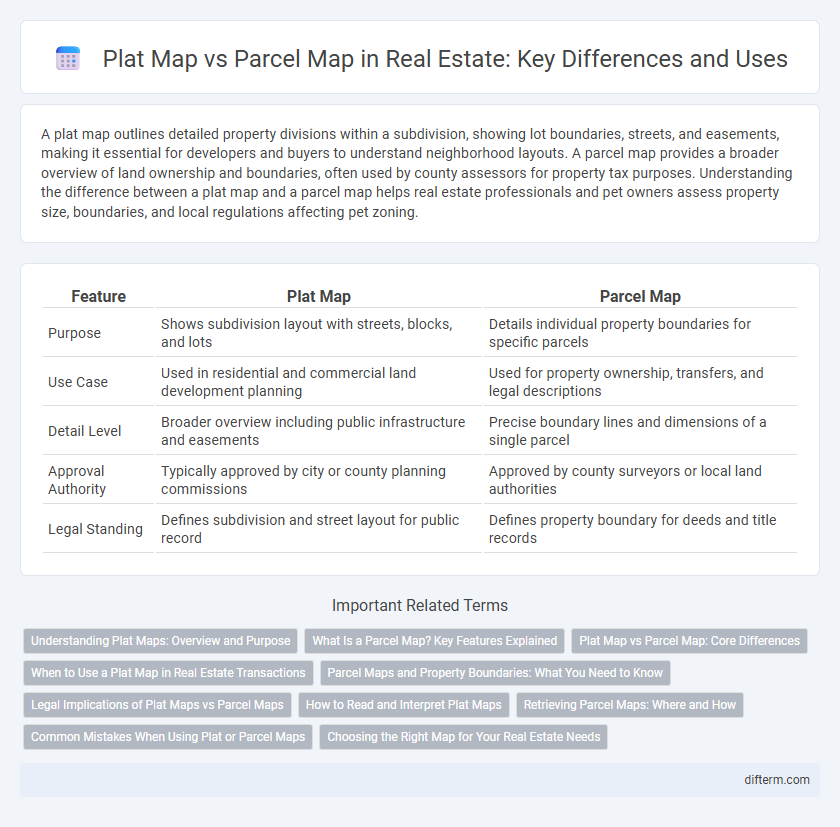A plat map outlines detailed property divisions within a subdivision, showing lot boundaries, streets, and easements, making it essential for developers and buyers to understand neighborhood layouts. A parcel map provides a broader overview of land ownership and boundaries, often used by county assessors for property tax purposes. Understanding the difference between a plat map and a parcel map helps real estate professionals and pet owners assess property size, boundaries, and local regulations affecting pet zoning.
Table of Comparison
| Feature | Plat Map | Parcel Map |
|---|---|---|
| Purpose | Shows subdivision layout with streets, blocks, and lots | Details individual property boundaries for specific parcels |
| Use Case | Used in residential and commercial land development planning | Used for property ownership, transfers, and legal descriptions |
| Detail Level | Broader overview including public infrastructure and easements | Precise boundary lines and dimensions of a single parcel |
| Approval Authority | Typically approved by city or county planning commissions | Approved by county surveyors or local land authorities |
| Legal Standing | Defines subdivision and street layout for public record | Defines property boundary for deeds and title records |
Understanding Plat Maps: Overview and Purpose
Plat maps provide a detailed, scaled representation of a property subdivision, illustrating boundaries, lot dimensions, streets, and easements critical for land development and municipal planning. Unlike parcel maps, which focus primarily on individual property ownership and tax assessment, plat maps are essential for legal descriptions, zoning compliance, and infrastructure layout. These maps facilitate clear communication among developers, surveyors, and local government agencies to ensure accurate land division and proper recording of land use.
What Is a Parcel Map? Key Features Explained
A parcel map is a detailed diagram that outlines the boundaries and dimensions of individual land parcels within a specific area, often used in real estate transactions and land development. Key features include precise property lines, parcel numbers, easements, and rights-of-way, which are essential for legal descriptions and ownership records. Unlike a plat map, which may show broader subdivision details, a parcel map focuses specifically on the subdivision of land into smaller parcels for sale or development.
Plat Map vs Parcel Map: Core Differences
Plat maps provide detailed layouts of subdivisions including lot boundaries, street locations, and easements, essential for developers and buyers to understand property divisions. Parcel maps focus on individual property units for legal identification and tax assessment purposes, often used by county assessors and surveyors. The core difference lies in plat maps addressing comprehensive subdivision planning, while parcel maps emphasize precise land division for ownership records.
When to Use a Plat Map in Real Estate Transactions
Plat maps are essential in real estate transactions when detailed subdivision information is needed, showing property boundaries, lot numbers, and easements within a development. Use a plat map to verify precise property lines, assess potential encroachments, and ensure compliance with zoning regulations before purchasing or developing land. Parcel maps, by contrast, provide broader information and are typically used for tax or public record purposes rather than detailed boundary verification.
Parcel Maps and Property Boundaries: What You Need to Know
Parcel maps are essential for accurately defining property boundaries and ensuring legal descriptions align with recorded land ownership. These maps display detailed information about individual property lines, easements, and lot dimensions, helping buyers, sellers, and developers verify exact parcel limits. Understanding parcel maps is crucial for resolving boundary disputes and planning property improvements in compliance with local zoning regulations.
Legal Implications of Plat Maps vs Parcel Maps
Plat maps legally establish detailed layouts of subdivisions, including streets, easements, and lot boundaries, which are essential for property development and municipal approvals. Parcel maps focus on smaller land divisions, primarily used for identifying individual property parcels for ownership and taxation purposes, but they often lack the comprehensive legal descriptions found in plat maps. Understanding the legal distinctions ensures compliance with zoning laws, accurate property descriptions in deeds, and clear title transfers in real estate transactions.
How to Read and Interpret Plat Maps
Understanding plat maps involves analyzing the detailed layout of land divisions, including property boundaries, lot numbers, street names, and easements, to accurately identify parcel locations and land ownership. Key features such as scale, legend, and boundary lines provide essential information for interpreting property dimensions and legal references. Accurate reading of plat maps ensures compliance with zoning laws, facilitates property transactions, and supports land development planning.
Retrieving Parcel Maps: Where and How
Parcel maps can be retrieved from local county assessor or recorder offices, which maintain detailed records of property boundaries and ownership. Many counties now offer online GIS portals or databases where parcel maps are accessible by entering a specific address or parcel number. Accessing these official sources ensures accurate and up-to-date information critical for real estate transactions and land development.
Common Mistakes When Using Plat or Parcel Maps
Common mistakes when using plat or parcel maps include misinterpreting boundary lines, confusing lot numbers with parcel numbers, and overlooking zoning restrictions indicated on the maps. Failure to verify map details against official county records can result in inaccurate property descriptions and legal disputes. Always cross-reference with current survey data and local planning departments to avoid costly errors.
Choosing the Right Map for Your Real Estate Needs
Plat maps provide detailed layouts of subdivisions with lot boundaries, streets, and easements, essential for understanding property development and zoning regulations. Parcel maps display specific property boundaries and dimensions, crucial for accurate land ownership and title research. Selecting the right map depends on whether you need comprehensive subdivision planning or precise parcel information for real estate transactions.
plat map vs parcel map Infographic

 difterm.com
difterm.com